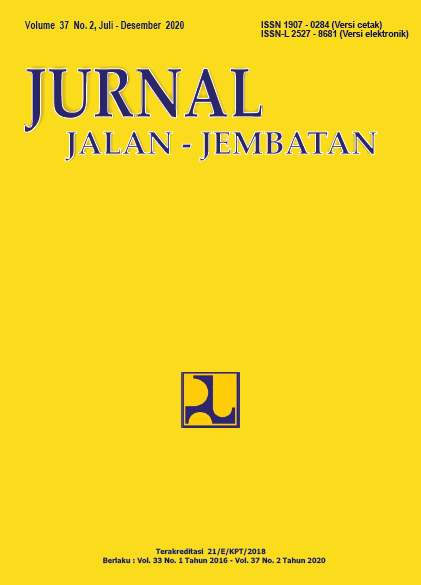REDUCTION EFFECT OF 4 LANES TO 3 LANES ON TOLL ROADS TO DELAYS AND QUEUES
Main Article Content
Abstract
Bottleneck is a phenomenon of reduced vehicle speed caused by narrowing of road, reduction of lanes, accidents or existence of a slow-moving vehicle. In general, these phenomena can be approached with the Shock Waves Analysis. This study aims to determine the Value of Shock Waves, Value of Queue, and Value of Delay ​​that occur because of the bottleneck. The location of the study was conducted on the Jakarta - Cikampek Toll Road Station 26. The road has four lanes but there are side barrier so that only three lanes operate. The study was conducted in 120 minutes from 09.00 until 11.00. The relationship of traffic characteristics will be tested using three approaches namely, Greenshields Linear Model, Greenberg Logarithmic Model, and Underwood Exponential Model. The statistical test results from three approaches show that Greenshields Model results better Correlation Analysis and Significance Tests than Greenberg Model and Underwood Model. Shock Wave Analysis using approach the Greenshields Model results formulation, if Demand of Flow (V) = 5292 pcu/hour/4-lane with Density (D) = 121.56 pcu/km/4-lane, then the Backward Forming Shock Wave (ωAB) = -116.56 km/hour, Backward Recovery Shock Wave (ωBC) = -74.33 km/hour, and Forward Forming Shock Wave (ωAC) = -23.98 km/hour. Based on Value of Shock Wave and Demand of Flow that, will inflict Queue (N) = 155 pcu/3-lane and Delay (T) = 77.62 pcu.minute/3-lane.
Keywords: shock wave, Greenshields, Greenberg, Underwood, queue, delay.
Article Details
Authors who publish in this journal agree to the following terms:
-
Authors retain copyright and grant the journal the right of first publication with the work simultaneously licensed under a Creative Commons Attribution License, which allows others to share the work with acknowledgment of the work's authorship and initial publication in this journal.
-
Authors may enter into additional contractual arrangements for the non-exclusive distribution of the journal's published version of the work (e.g., post it to an institutional repository or publish it in a book), with acknowledgment of its initial publication in this journal.
-
Authors are permitted and encouraged to post their work online (e.g., in institutional repositories or on their website) as it can lead to productive exchanges, as well as earlier and greater citation of the published work.
Each submitted manuscript must be accompanied by a "Manuscript Originality Statement" and a "Copyright Transfer Statement".

